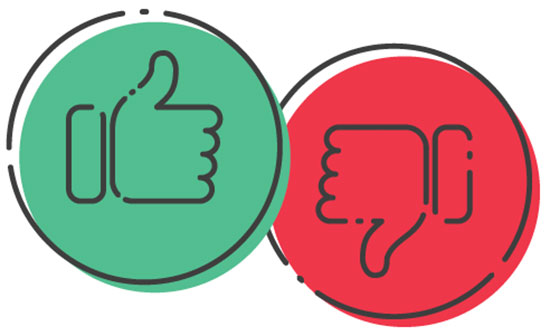THE DO’S AND DON’TS
OF CREATING A SOCIAL MEDIA STRATEGY
ONE OF THE FOUNDATIONS OF MARKETING IS MEETING YOUR CUSTOMERS WHERE THEY ARE, AND IN 2020, IT OFTEN MEANS ON SOCIAL MEDIA.
According to the Pew Research Center, around seven-in-ten Americans use social media,1and for many of them it’s a part of their daily routine. It’s not a matter of should your dealership or range be on social media, but how to best utilize these platforms effectively.
Last month, we shared timesaving tips for managing your social media. Here, we’ll dig deeper into one of the topics touched on — how to develop a social media strategy and create a content schedule.
TAKE AN AUDIT
Before it’s possible to create a social media strategy, you first have to establish a baseline. What platforms are you on? How often do you post? What types of content perform well? And which ones not so much?
Stephanie Krop, co-founder of The Machine Gun Nest in Frederick, Md., recommends taking time to talk about your specific brand.
She suggests asking what makes you different. Do you specialize in excellent customer service? What does it look like, and how do you implement it? What colors and fonts are associated with your brand?
“Spend time and really take it from abstract to definite,” she advised.
While you’re doing this take a hard look at each of your accounts and take notes about how they can be optimized. Some areas in need of improvement may include updating account names and custom URLs so they are as consistent as possible, using the same profile picture to make it easier for customers to know it’s you and making sure your profile is filled out completely with up-to-date information. Pay close attention to the address, phone number, email address and business hours. When one of these has changed, updating it on your profile may have been overlooked.
SET GOALS
Ask yourself two more questions: what would you like to gain from using social media for your business, and what would you like your customers to gain from you? Maybe you want to increase participation in your training courses or show those in your community you’re interested in more than just selling guns.
Determine what metrics you will need to track to measure success. While the easiest metric to track is your number of followers, it’s not necessarily indicative of whether the strategy is working. Metrics like reach and engagement are often better indicators.
EVERY SINGLE POST YOU MAKE ON SOCIAL MEDIA SHOULD ALIGN WITH YOUR BRAND, OVERALL STRATEGY AND EITHER YOUR SHORT- OR LONG-TERM GOALS.
CREATE A PLAN
Once your goals have been defined, it’s time to create a plan. Every single post made on social media should align with your brand, overall strategy and either your short- or long-term goals.
“You want to avoid hodgepodge posting,” Krop noted. “For us, a well-made plan leads to a brand communicated well. The goal is to have potential customers consume your content and get a ‘feel’ for what you’re all about and have that extend into your facility.”
Krop suggests creating a plan for at least six months, but it can be both overwhelming and time-consuming for small- to medium-sized businesses where time is often the most valuable commodity.
Seth Dortch, marketing manager of Final Flight Outfitters in Union City, Tenn., plans their post schedule a few weeks at a time, while their overall strategy is constantly changing because consumers are always changing.
“Scheduling posts allows me to look with a big-picture perspective to make sure they integrate with our branding, engage our customers and actually maximize the potential of our posts rather than just kicking out whatever and whenever,” he said.
FOCUS ON CONSISTENCY
Advance planning also helps ensure you’re posting consistently. When I’m searching for potential firearms dealers to interview for stories, I always take the time to look at a company’s Facebook page. More often than not, I stumble across active accounts that haven’t posted in several weeks, months or even years. (Or accounts that have never been claimed in the first place.)
Professional marketers tend to fall on two sides of the fence when it comes to how often you should post. Some recommend posting as regularly as possible to stay top of mind. Others suggest only posting if you have high quality and valuable information to add to the conversation. Either way, it’s important to know your post frequency often has a direct effect on how many people will potentially see your message.
“Typically, we post once a day on Facebook and Instagram,” relayed Dortch.
How often to post also depends on the platform. The latest marketing research suggests the following for maximum visibility:
• Facebook: 1–2 times per day.
• Twitter: 3–10 times per day.
• Instagram feed: 1–3 times per day.
• Instagram stories: 2–5 times per day.
• LinkedIn: 3–20 times per day.
As far as the best time of day to post, the answer is simple: when your audience is online. Regularly looking at your analytics can reveal which days of the week and at what times your followers are using social media.
INCORPORATE A MIX OF CONTENT
Another way to keep users engaged is by posting a variety of content. Don’t just post every time you’re having a sale on certain rifles or have seats to fill in a concealed carry course.
“For us, the social media posts that perform the best are the ones that actually reveal the humanity in our brand as people,” said Dortch. “Many variables come into play such as creativity, simplicity, emotional appeal, etc., but overall, people simply just want to connect with authentic content and not feel like they’re being sold to.”
Non-product related posts could include behind-the-scenes content like a photo and fun fact about a different employee each week or safety/educational tips.
Another easy way to fill your content calendar is by mixing in posts for popular social media holidays and federal holidays. Maybe it’s a picture treating your staff to lunch on #NationalPizzaDay or live video of an in-store Easter egg hunt.
Be sure to also use a variety of formats. For instance, video posts on Instagram receive up to 49% higher interactions.2Other formats include shared articles or blogs, photos, polls, gifs, memes and more. Be sure to adjust the plan as you learn what types of posts your audience prefers.
Let’s say one of your top-performing posts was a blog shared from your website about different types of holsters to conceal carry. Maximize this reach by repurposing some of the same content in another format, like video. Half the battle of creating a social media posting strategy and content calendar is learning to work smarter and not harder. You don’t have to reinvent the wheel with every single post.
AFTER ALL, THE USERS WHO FOLLOW YOU ON FACEBOOK, INSTAGRAM OR TWITTER AREN’T JUST STRANGERS ON THE OTHER SIDE OF COMPUTER SCREEN OR MOBILE DEVICE.
LEVERAGE YOUR RESOURCES
If all of this sounds like a lot of work, well, it’s because it is. To get the most out of social media you’ll want to hire at least one employee whose background or experience includes digital marketing and social media. While anyone can create a profile and publish a post, the social media landscape is ever-evolving so someone dedicated to learning and implementing the latest best practices is essential.
There are also countless tools and resources, many of which are free, to help implement a social media strategy.
“The main resource we use for social media management is Buffer for post scheduling,” Dortch shared. “Personally, I utilize a ton of apps and access a lot of information by listening to podcasts, researching trends, readings articles, etc.”
Other recommended resources include the Canva app to create branded graphics and other designs, the e-newsletter from Social Media Today which highlights the latest industry trends and updates and the Facebook Page app which allows you to manage your business page and keep some separation from your personal profile.
YOU DON’T HAVE TO “PAY TO PLAY”
Even the best-laid plans will come with a few challenges when it comes time to execute. Without a doubt, the greatest social media challenge facing the firearms industry is the strict advertising guidelines prohibiting ads that promote the sale or use of weapons, ammunition and explosives (including weapon-modification accessories). Continued attempts to violate this policy can result in your profile being shut down entirely, either temporarily or permanently.
Some dealers and industry manufacturers have found success using ads to promote safety products, like safes or events, so long as they’ve flexed some creative muscle to avoid the mention of firearms. The good news is contrary to what some marketing experts will tell you, you don’t have to “pay to play” on social media.
“All of our social media engagement and growth is done organically except for partnership campaigns we do with manufacturers,” Dortch stated. “We’ve been heavily monitored and shut down by advertising restrictions in the past because of the products we sell. A change in strategy has enabled us to be an example of how social media marketing’s potential for firearms retailers can be maximized when done right.”
Their organic strategy with a focus on engagement must be working because even without paid advertising Final Flight Outfitters has been able to grow its Facebook audience to more than 15,500, nearly 9,000 on Instagram and over 1,800 followers on Twitter.
KEY TAKEAWAYS
We’ve covered a lot of ground, and as daunting as this all may seem, these best practice tips are the tip of the iceberg. So, when it comes to creating a social media strategy and content schedule what’s the key takeaway? Dortch summed it up best:
“Provide entertainment, education and inspiration with transparency and relevancy. Don’t just market to the emotions of people; connect with their hearts. And most importantly, don’t view people as numbers, see them as individuals you want to help succeed and grow.”
After all, the users who follow you on Facebook, Instagram or Twitter aren’t just strangers on the other side of computer screen or mobile device. Taking the time to engage and cultivate meaningful relationships with current and potential customers through social media can have a lasting impact on the long-term success of your business






